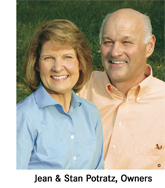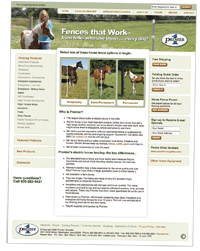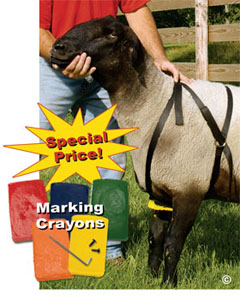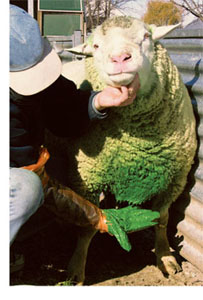Message from the Owner
Responding to High-Cost Feed, Fuel and GroceriesThe situation some rural US residents now face has echoes of our parents and grandparents world. That being so each of us should look back in time for understanding and look forward to possibilities. That's a sentence with many big words-so some specific ideas:
So why not produce your own? Your grandparents did. So can you. A leading garden seed supplier recently noted that $1 of garden seeds will produce $20 in fresh vegetables. (I can't verify this and admit to his evident self-interest). You cannot get a financial return like that from stocks, bonds, or farmland-and you don't have to pay taxes on the value produced. Modern tools make small-scale gardens much easier than they were 40 years ago. What if you produce more than you can use? Local farmer markets are growing in popularity. And the $ available aren't trivial. One of Premier's employees sold $250 worth of their own sweet corn in one evening. Yes, you will have problems (weeds, rabbits, groundhogs, deer). But education via the internet is free. Advice, solutions, seeds and tools are only a search-engine away. If you do it properly and involve your family it will also produce higher personal fitness and enhanced flavor on your family's plate. by Stan Potratz What's New
Now Live! - Premier's NEW Horse Fence Websitewww.horsefencesthatwork.com
You can still visit www.premier1supplies.com for all species and products. Special Price from Premier!
Save $0.50 on each Marking Crayon!(Remember: FREE SHIPPING on qualified website orders) Marking CrayonsUse marking crayons with Premier's Nylon Breeding Harness or Cross Your Heart Breeding Harness. Premier's crayons are made exclusively for us and come in five colors. A metal pin and 2 plastic pins are supplied with each crayon (shown with crayons at right). The hot crayons are reported to hold up better than any other "hot" crayon in the high temperatures of mid-summer. Three average daily high temperature ranges: Cold (25 - 65°), Mild (65 - 85°) and Hot (85 - 100°). This offer cannot be combined with any other claim codes or offers. However, free shipping on qualified website orders still applies. Promo Codes: For phone orders: NEWSC Order soon! Offer expires September 15, 2008Premier Tip
Are You Ready for Breeding Season?As breeding season approaches for most flocks across the country making plans for this important season is often overlooked. Aside from the essential first step of making sure you have enough "ram power", there are a series of other management procedures and techniques that can be used to ensure the season is a success.
Hopefully these tips will give you a jump-start on your planning. Good luck on the upcoming breeding season. Premier VIPContinuing EducationThe Cornell Cooperative Extension Learning Farm is located in Canton, NY. We are part of our local county extension office and we are a long ways from Ithaca where Cornell University is located. However, like them, our mission is education. Livestock and crop demonstrations, ag awareness activities for schools and the public, maple production, 4-H activities, and an FFA agriculture program are our main operations. My job mostly revolves around the animals at the farm and using them in educational ways. Three times a week I have students from a high risk group that come and assist at the farm and once a week a group of 8 to 11 year olds come to do school related things. There are also work-study students from the local college, most of whom are part of the veterinary tech program. It's a good thing we have lots of volunteers and groups visiting the farm because like most farms we are short on labor and cash and we are trying to use the resources we have to the fullest (at the same time we are trying to keep a lot of committees happy) and not spend too much money. Other staff from the office are working on trees, dogs, horses, alternative energy (hay pellets), and many groups such as the Maple Producers, North Country Shepherds, Farm Bureau, etc., that meet at the farm. There is a steady stream of busses, vans and cars coming and going. The sheep operation has been part of our livestock demonstration for quite awhile. The sheep flock has had as few as 35 and as many as 150 sheep but we are currently running around 70 ewes (including ewe lambs) for quite awhile now. Seventy is a comfortable number to run in our converted dairy facilities and a small open front barn. Our sheep are primarily Dorset based but our base was Finn-Dorset 10 years ago. In the past we have run a Polypay ram, many Dorset rams and are now trying an Ile de France ram. We basically want a short, chunky, white-face ewe with lots of milk and good mothering abilities. We have selected on weaning weights and out of season breeding for many years. For years we operated on the Cornell STAR system lambing five times per year. Labor became an issue and we went to lambing twice a year. The first lambing is in March and helps provide lambs for the breeding stock market and also avoids lambing in the 20 below zero weather in January and February. The second lambing is in the fall to have lambs for the Christmas market. Fall lambs are vigorous and the ewes are always in good condition after a summer of rotational grazing. The ewes that are not lambing until spring stay out on the pasture until mid-December (with round bale hay as supplement when needed). We use a five strand high tensile fence as a perimeter for the pasture and ElectroNet or TensionNet for dividers. The pasture is divided into about 6 paddocks and the back three are hayed before we graze them. There is a rotation but it is not super intensive. The coyotes have been a problem in the past, even killing sheep in the middle of the day. Our Great Pyrenees guardian dog, llamas and beef cattle stationed in the pasture next to the sheep pasture have kept the coyotes at bay so far this season. We also made an effort to get the charge up on the perimeter fence and mow around the outsides of the fence to eliminate cover. Our lambs are marketed to the eastern market. Some go as hothouse and some at 70 to 80 pounds. A few are sold as freezer lambs, usually at about 110 pounds. About half of our lambs are sold for breeding stock. Our marketing options include a local graded sale at Easter and Christmas, coordinated truckloads to New Holland, PA, and working with a co-op in Vermont that markets to New York city Restaurants. Our lambs never leave the barn (at least not on purpose). They are born, nurse their mothers and start on creep and then are weaned onto a full grain diet. The grain is high in digestible fiber so they can eat as much as they want. Our gains are between 0.5 and 1 pound/day, which allows us to move lambs to market quickly. Our lambing percentage runs about 1.8 to 2.0 lambs born. Most lambs are born on their own without staff being present. Our flock is enrolled in the voluntary scrapie program and is certified scrapie free. We try hard to provide good, easy care breeding stock for local (and not so local) farms. Most of all our sheep provide a good educational demonstration for 4-H sheep camp, hands-on training for beginning farmers and Vet Tech students, are willing victims for the shearing school and herding dog training (maybe not so willing) and entertain many school kids with their antics. Article by Betsy Hodge Premier Employee Spotlight
Barb MottetBarb Mottet from Brighton, IA is this month's featured employee. For two years she has been one of our computerized laser operators for imprinting our customized ear tags. She says that what she likes best about her position "is the connection that it has to farming. It's interesting to see all of the different places the tags are sent. It is also amusing to hear about what other animals we are making tags for besides normal farm animals." About Premier, what she likes best is that the business is located in the country on a farm. Barb says "I feel like I have gone back to my roots. It's fun to see the products that Premier sells being used on a daily basis here on the farm. I really appreciate Premier's honesty and business practices. It is also extremely important to me to be in an atmosphere where people are treated with respect. Premier's people are wonderful to work with." Barb and her husband Dan live on a farm and raise corn, soybeans and hogs. They also do custom farming for an organic operation nearby. They have two children, daughter Dana and son Curtis. Dana is 23 and specializes in assisting children, 12-18 with drug and alcohol related problems. Curtis, who is 20, is a junior at Iowa State University and is pursuing a major in agronomy and a minor in animal science. They of course have farm pets with a dog that loves to take 4-wheeler rides and a house cat that is helping Barb and Dan make it through the "empty nest syndrome". Her favorite statement is the Golden Rule: Treat others as you would like to be treated. "Life is so much more enjoyable when people show love and respect for others." Well said Barb!! RecipePotato Cheese SoupIngredients: 10 medium potatoes Peel and dice potatoes, then add celery and onions. Add enough water to just cover the vegetables. Cover and simmer until tender, about 20 minutes. Don't drain. Add soup, sour cream, Velveeta cheese and meat. Stir until the cheese melts. Garnish with dill weed. from Brenda McArtor, Premier employee |






